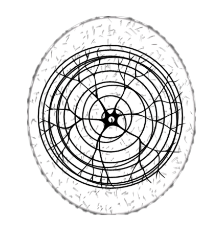Shae. I describe Complexity Patterning as a metacognitive strategy for relational experience and understanding, and it is most effective when students’ own identity and experience of life is the first complex phenomenon of focus. I’m convinced pattern thinking is useful for the cultivation of the type of systemic consciousness you describe, because patterns are a metaphenomenon throughout the universe. Complexity Patterning, as a language for the complexity of life, does not have any kind of linear grammar: it’s a dynamic multilevel patterning that is open to any creative engagement. If students come up with their own patterning, it doesn’t matter; it’s their direct embodied experience of relational sentience and the awareness and knowledge they generate that is important.
Alexander. There is a paradox in there. The perennial aspects of life: on the one hand, you express as constant, and on the other, ever changing. There are aspects of the Complexity Patterning, the spiral patterning, for example, that help us remember the patterning of our own being. To remember the song of Self as also remembering those bigger patterns that bring us back into a relationship. In Spanish, remembering is recordar… to bring accord, for ourselves, with everything. Religion has that element from Latin, as well: religare… to bring us back into connection with spirit, to re-connect, to re-member and re-story our relationship within the great hoops of life, or however one may wish to put it.
There are certain aspects to Complexity Patterning which call in this re-membering relationality. The paradox is that if we imagine any forms of patterning as fixed structures, they become a straight jacket of thinking, but to say there is no structure, just an oceanic flow, becomes the opposite, with no form. It is this balance between constancy and change which allows for scaffolding of the patterning: the scaffolding emerges and changes, and emerges again and flows. As my friend David Schulhoff put it, “it is the shuffling of the deck between hands that creates the play of emergent order each round the cards are dealt.”
A Patterning Ontology
Shae. I think with a patterning ontology, that’s what patterns do in the universe: they enable change within a certain amount of constancy through the holding of shape and form. A pattern will hold enough for energy and information to become a something, and it will do so long enough in time for the something to gain qualities and experience. Patterns are also open enough for flow and change; that is the nature of patterns themselves, as far as I understand them. And different patterns have different qualities. With spheres holding more firmly than a mycelial patterning, which is branching and distributing and communicating, and a spiral pattern has some holding qualities and are moving along at the same time. So, the different shapes and patterns have different qualities in the balance of that capacity to hold and enable and allow, all at the same time. Which is the paradox of existence, the dance that we live every day, not doing everything the same but the same enough to enable us to do something else — but not doing it the same enough that we get stuck. It is an interesting paradox all the time.

Complexity Patterning
A Dance Indeed!
Alexander. Yes, keeping the groove from becoming a rut, but allowing for some path-dependence so that we can stay in the groove. A dance indeed! It recalls a quote from Erich Jantsch who said that “to live in an evolutionary spirit means to engage with full ambition and without any reserve in the structure of the present, and yet to let go and flow into a new structure when the right time has come.” Ha! Anything else is dogmatism or passivity. If you say, “I’ll just let it happen,” that is abandonment of engagement. And yet, to really fully determine some co-creative act you can end up going off in a different direction. Still, evolution always goes off in different directions, so how do you flow with it confidently? This is again the call for syntony. The dynamics of emergence are always coherent on some level. If you look (or sense) closely enough, you will see that things are always in some way connected, even if they express as a stochastic process. And somehow, we can see how it is part of what went before. It usually happens in retrospect because if you are looking at bifurcations you usually can’t say what the outcome will be, but later you can say, “okay, I can see how we went through that quantum leap there,” like with the development of telephony in India where they didn’t develop landlines first and simply leapfrogged straight to cellular telephony in the uptake of that technology. Being able to see those evolutionary patterns is important, and that’s where cultivating one’s syntony sense comes in handy.
